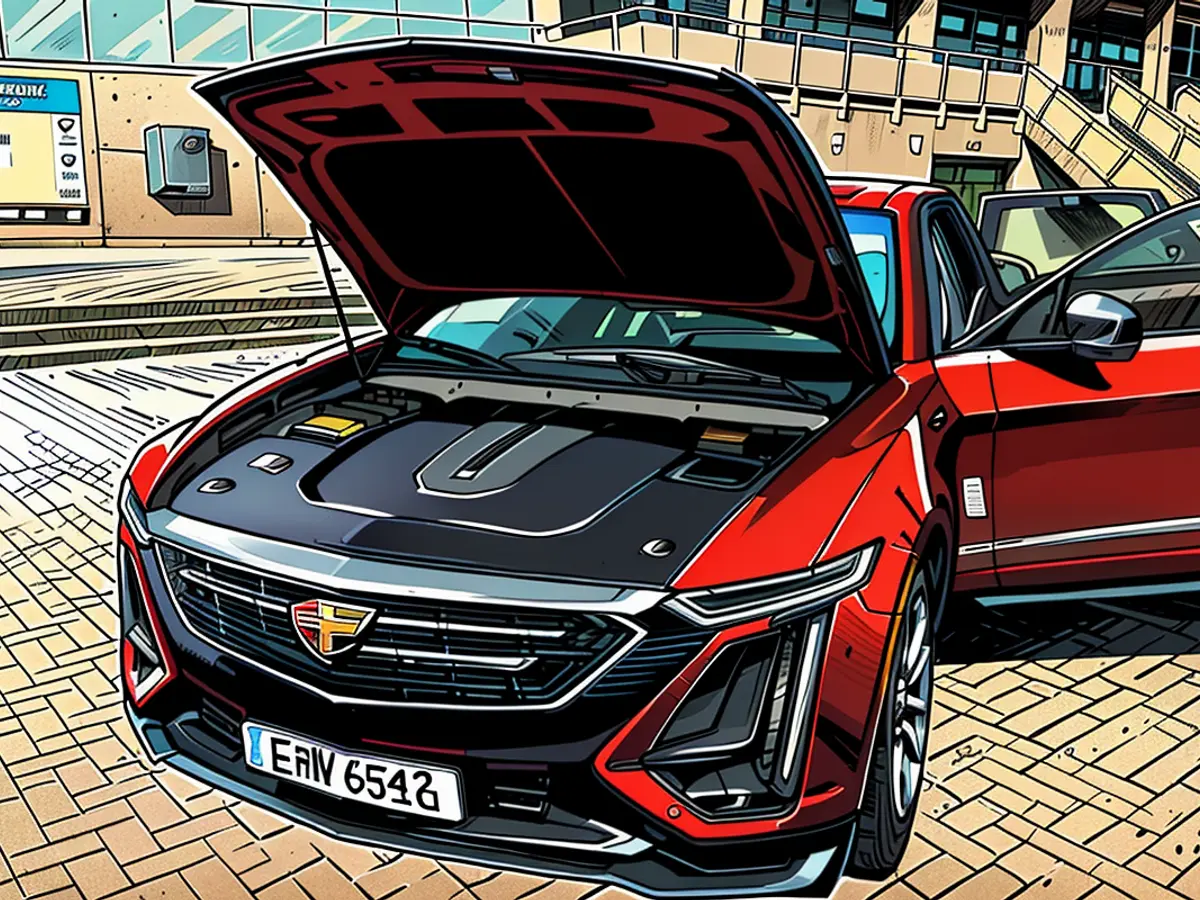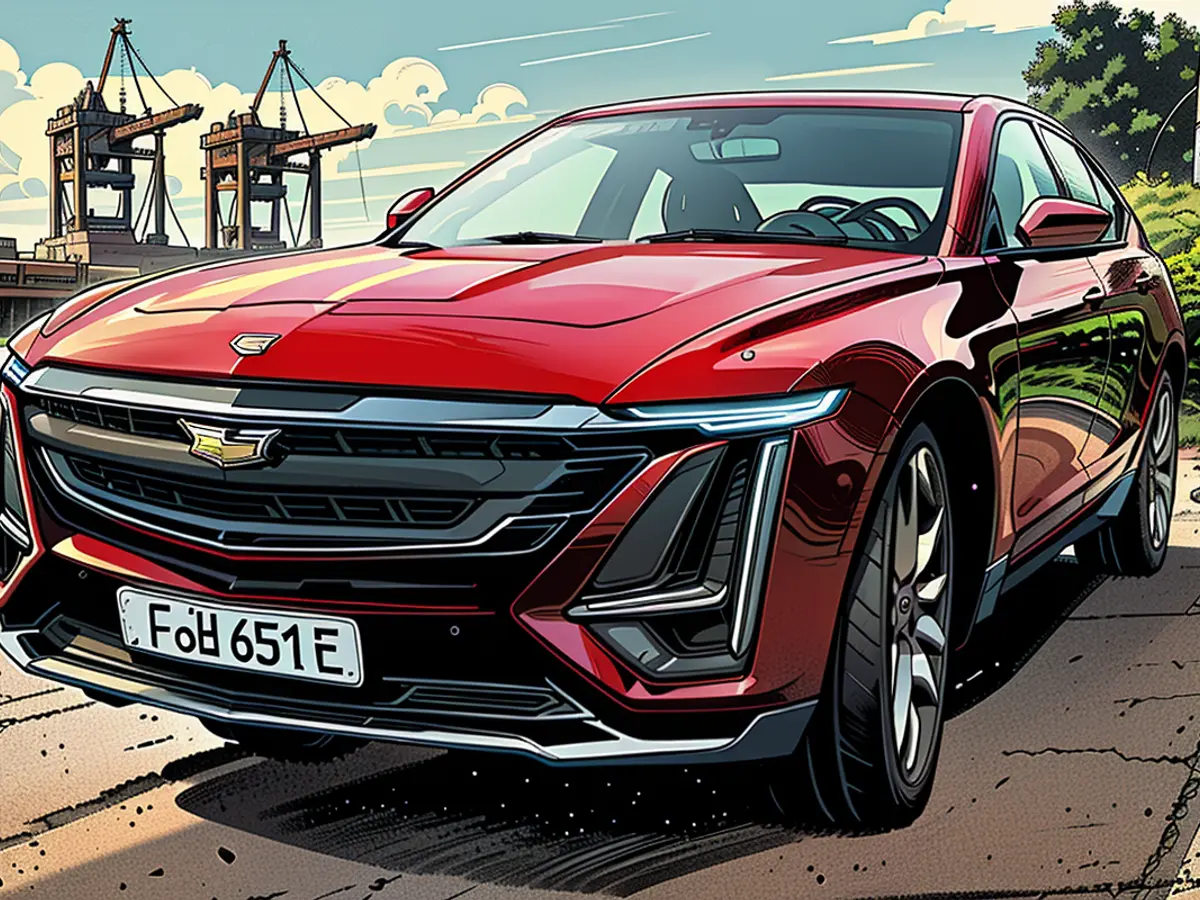- The Cadillac Lyriq serves as an ideal rival to the Tesla, without a doubt.
Seven years ago, General Motors (GM) departed from Europe. Nevertheless, a potential return to the local market had been under consideration for quite some time. Recently, the initial return vehicle, the Cadillac Lyriq, has made its way back into Germany. Upon first glance, it's likely that some may be taken aback. Few individuals would likely anticipate another SUV. However, considering Cadillac's prominent brand presence, one may be able to overlook this.
The German variation of the Lyriq is manufactured in Spring Hill, Tennessee. In essence, the automobile possesses a decidedly American core. This is clearly apparent not just in its size but also in minor details, such as the use of a US power outlet in the rear, which Cadillac may choose to replace in customer vehicles. In the test vehicle, it proved to be relatively useless without an adapter.
On the other hand, it's a shame that GM didn't merely maintain the American components. The EU version falls short in several aspects that contribute to the vehicle's popularity in its native country. For instance, the "Super Cruise" driver assistance system, which significantly enhances driving comfort on American highways, is absent.
In Germany, only a cruise control with distance regulation remains. Similarly, the lighting of the Lyriq is scaled back: While the American version boasts a fully illuminated "radiator grille" that sets the car apart optically, Europeans must make do without this visually exciting feature. Instead, they are more restrained, at least as far as this large vehicle allows.
But what remains when one decides on the Cadillac Lyriq and is prepared to pay the fixed price of 80,500 euros? Fixed price, as both variants (Luxury AWD and Sport AWD) cost the same and there are only a few options (trailer hitch and roof rack, as well as leather and exterior color) for both models.

A Ton of Comfort
First and foremost, drivers can expect a reliable electric vehicle with sufficient power. The engines collectively deliver 528 horsepower and 610 Nm of torque. This results in acceleration from 0 to 100 km/h in 5.3 seconds and a top speed of 216 km/h on the speedometer, after which it is locked. For a vehicle with a curb weight of 2.8 tons, that's quite impressive. However, there is no cause for celebration regarding the weight - the gross weight of 3.2 tons is quickly reached, and towing is temporarily prohibited for drivers with a standard license.
The good news: During the drive, the Lyriq's weight goes unnoticed. It drives as light as a feather, much like a typical American vehicle, offering a highly comfortable and softly tuned ride. Nevertheless, the car does not waver, unlike one might expect from American road cruisers. It is reported that the suspension has been adjusted to be slightly firmer for Europe - but the current setting is certainly suitable for the Lyriq. The one-pedal driving mode with optional extreme regeneration is also expertly implemented. Additionally, there is a steering wheel paddle that allows for stepless regeneration, and with practice, minimal use of the brake pedal is necessary.
It's best to avoid excessive speed with the vehicle, as it already consumes a great deal even in normal operation. Despite the impressive battery capacity of 102 kWh, it's a struggle to exceed 400 kilometers without a charging stop. In the test, the Lyriq's consumption leveled out at about 25 kWh per 100 kilometers, but careful attention was paid to consumption, and a maximum of 130 km/h was driven on the highway, while city traffic with correspondent regeneration was interspersed.

Charging Technology Needs Improvement
At the fast-charging station, the Lyriq does not make a particularly favorable impression. The 400-volt system allows the vehicle to reach a maximum charging speed of approximately 190 kilowatt hours, but only for very short periods. It takes about half an hour to charge from 10 to 80 percent, which is average. The charging performance at the alternating current station is commendable, as it is 22 kilowatts and significantly impacts, particularly for short shopping trips or inner-city parking. The charging port is situated in front of the driver's door, which simplifies parking in front of charging stations. However, the arrangement is less than perfect, as when using street-side chargers, one will inevitably be on the sidewalk, and the plug will extend sideways towards traffic.
The cables are stored under the trunk's floor in the Cadillac. The double floor offers ample room for this. Although the Lyriq is not a pack mule par excellence, it can still accommodate a decent amount. With the rear seats upright, there are approximately 800 liters of cargo space, and when they're folded down, it's 1722 liters. Unfortunately, there's no frunk, or storage space under the massive hood, for reasons that remain unexplained.
Those who worry about safely maneuvering the colossus from point A to point B will appreciate the numerous cameras on the vehicle. While the traditional rear-view width is somewhat limited, the digital rearview mirror, the display, and the blind-spot warning systems contribute to preventing collisions. The Lyriq can park itself if it accurately identifies the desired parking space. The Cadillac alerts drivers to obstacles using seat vibrations by default, which may feel unusual at first, but one quickly becomes accustomed to it. If not, one can switch to traditional beeping.

Inside this Cadillac, it feels more like a moving lounge than a racecar. The seats are plush and comfortable, feeling more like a plush armchair rather than a racing seat. While they may lack in side support, they compensate with ample padding for comfort. There's also a subtle massage function and optional seat heating or cooling for added comfort.
The large 33-inch display keeps the driver informed during the journey, with the vehicle navigating using an adapted version of Google Maps by default. The software, Android Automotive, is responsive and even features an app store for downloading various programs after signing in with Google. Unlike navigation apps on a smartphone, the integrated software can calculate the remaining range and estimate the arrival time, planning charging stops accordingly. This feature worked well during testing.
There are numerous storage areas and compartments around the cockpit, and the sound system is top-notch. The AKG speakers produce great sound and offer a type of noise cancellation that reduces external noise. Combined with thick windows, this creates a remarkable effect: Standing next to a construction site with the Cadillac Lyriq, you can barely hear it. But as soon as you open the window, it's like breaking through a sound barrier. The noise outside seems deafening. This level of silence was last felt in the Rolls-Royce Spectre. For city dwellers, the Lyriq's interior is a peaceful sanctuary.
In terms of craftsmanship, the Lyriq is generally well-made, but there are a few weaknesses. Visible surfaces are well-made, but less visible areas, such as the underside of the center console, reveal some creaking. While there are only a few such spots, they are hard to ignore. A few better plastic trims could have improved this.

Conclusion: Cadillac Lyriq - A Likeable Car with a High Price Tag
In the U.S., the Cadillac Lyriq is popular due to its base configuration, which offers a credible challenge to the beloved Tesla Model Y. Starting at $59,000, U.S. Cadillacs offer value comparable to Tesla's prices. In this scenario, minor creaking interior trims are not a significant concern.
In Germany, where the Lyriq starts at €80,500, it enters a different price league, competing with the BMW iX, Kia EV9 (reviewed here), or a Mercedes-Benz EQE. This is tough competition from well-established brands with a different reputation at these price points. Whether Cadillac can succeed with the Lyriq as a quasi-newcomer among these customers remains to be seen.
If more variants and accessories had been included in the configurator, starting at around €60,000 – although this is still a significant sum – more people might have been reached. It may take some time, but in its initial steps, the brand's comeback seems tentative and out of reach for many potential customers. Perhaps the Optiq, the next European introduction, will change this.

In its own right, the Lyriq is a good car with minor faults. It offers a touch of American-style roominess, which is not found in its competitors. If this is important, one might overlook its competitors' advantages. At the very least, it is visually distinctive, even without its front lighting.
The Cadillac Lyriq, with its American-made core, is set to make a considerable impact in the German market, particularly with its distinctive features such as the use of a US power outlet in the rear. Despite the absence of certain features in the EU version, like the 'Super Cruise' driver assistance system, the Lyriq still offers a comfortable and smooth drive.
Cadillac's decision to manufacture the German version of the Lyriq in Spring Hill, Tennessee, ensures that the vehicle maintains its American essence, evident in its size and minor details. This American influence extends to the interior of the vehicle, offering a level of comfort and noise reduction not often found in European competitors.








